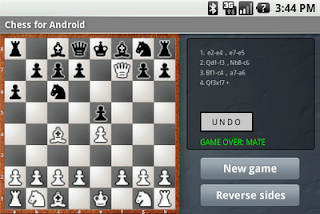Chess for Android Update

Version 1.2 of Chess for Android at the Android Market has several improvements. The first is the much requested "undo" feature, where up to eight plies (half-moves) can be taken back to correct mistakes in the input (or mere blunders, as for black in the screenshot below!). The second is a "free play" option, where the phone can be used as a "magnetic chessboard" to study games, or play a game up to a position for further play with the chess engine (this option, like the different levels of play, can be found under the "Menu" button). Furthermore, move highlighting has been modified with a black border, which looks slightly better along files and ranks. Finally, a few rules were added to evaluation function of the chess engine.



